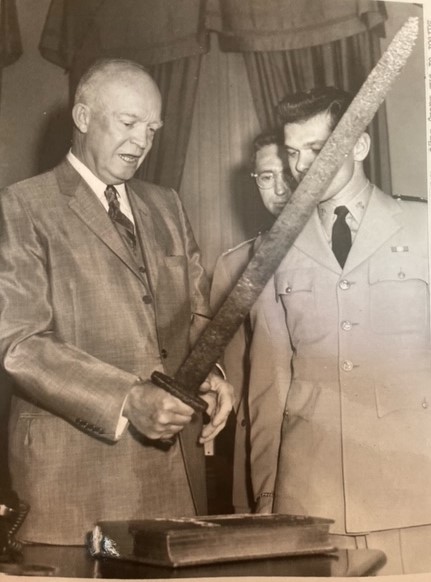A Petersen Type ‘M’ Sword in the Naval Academy’s Collections: Viking History Meets the Modern Navy
DOI:
https://doi.org/10.25071/2561-5467.1163Keywords:
Viking Age Weaponry, Archaeology, Operation Weserübung, Nazi Propaganda, King Olav V of Norway, United States Naval AcademyAbstract
Sometime between 850-950 CE a 91cm single-edged sword was forged in Viking Age Norway. Eventually, that sword was placed in the earth, likely buried alongside its owner. Roughly 1,000 years later (in 1957), that sword was presented to the brigade of midshipmen at the United States Naval Academy by President Eisenhower. The artifact has the distinction of being the oldest weapon in the Naval Academy’s possession. This essay considers what forensic and archaeological evidence can tell us about the sword’s hitherto unknown history and also explores this artifact’s modern provenance and connection to US-Norwegian maritime relations in the mid-twentieth century.
Entre 850 et 950 EC, une épée à un tranchant de 91 cm a été forgée dans la Norvège de l’ère des Vikings, puis elle a été enterrée, probablement aux côtés de son propriétaire. Environ 1 000 ans plus tard (en 1957), le président Eisenhower a présenté l’épée à la brigade d’aspirants de marine à l’Académie navale des États-Unis. L’artéfact a la particularité d’être la plus ancienne arme en la possession de l’Académie navale. Le présent article traite de ce que les preuves médico-légales et archéologiques peuvent nous dire au sujet de l’histoire jusqu’ici inconnue de l’épée et examine la provenance moderne de cet artéfact ainsi que son rapport aux relations maritimes américano-norvégiennes au milieu du 20e siècle.
References
Aannestad, Hanne Lovise. “Charisma, Violence and Weapons: The Broken Swords of the Vikings.” In Charismatic Objects: From Roman Times to the Middle Ages, edited by M. Vedeler, I. M. Røstad, E. S. Kristoffersen and Z. T. Glørstad. Oslo: Cappelen Damm Akademisk, 2018. 147-168. DOI: https://doi.org/10.23865/noasp.51
Adams, Sherman. Letter to Mr. Louis de Rochemont. 5 June 1957. Eisenhower Presidential Library.
Androshchuk, Fedir. Viking Swords: Swords and Social Aspects of Weaponry in Viking Age Societies. Stockholm: The Swedish History Museum, 2014.
Aurand, E. P. Memorandum for the President. 4 June 1957. Eisenhower Presidential Library. Blindheim, Charlotte, B. Heredahl-Larsen, and Anne S. Ingstad. Kaupang-funnene. Bind II. Gravplassene i Bikjholbergene/Lamøya: Undersøkelsene 1950-1957. Del A. Gravskikk, Oslo, 1999.
Boehm, Hermann. “Die politische Entwicklung in Norwegenen der Zeit siet der Besetzung 1940 bis zum Frühjahr 1943.” Undated position paper. Handmaterial Ob.d.M., Denkschrift Gen. Adm. Boehm (Norwegen 1940-1943). RM 6/89, Bendesarchiv-Militärarchiv Freiburg, Germany.
Brunning, Sue. The Sword in Early Medieval Northern Europe: Experience, Identity, Representation. Woodbridge: Boydell, 2019. DOI: https://doi.org/10.1515/9781787444560
Eisenhower, Dwight. Letter from the President to His Royal Highness Olav, Crown Prince of Norway. 4 June 1957. Eisenhower Presidential Library.
Emberland, Terje. “Pure-Blooded Vikings and Peasants: Norwegians in the Racial Ideology of the SS.” In Racial Science in Hitler’s New Europe 1938-1945, edited by Anton Weiss-Wendt and Rory Yeomans. Lincoln: University of Nebraska Press, 2013. 112-117.
Foreningen til Norske Fortidsmindesmerkers Bevaring Aarsberetning for 1876. Werner and Komp: Kristiania, 1877.
Fure, Jorunn Sem. Universitetet i kamp 1940-1945. Oslo: Vidarforlaget, 2007.
Gardeła, Leszek. Amazons of the North: Women and Weapons in the Viking World. Philadelphia and Oxford: Casemate, 2021. DOI: https://doi.org/10.2307/j.ctv24q4z0f
Saxo Grammaticus, Gesta Danorum. Edited by Karsten Friis-Jensen and translated by Peter Fisher. Oxford: Clarendon, 2015.
Glørstad, Zenette Tsigaridas. “Signs of the Times? The Transfer and Transformation of Penannular Brooches in Viking-Age Norway.” Norwegian Archaeological Review 45 (2012): 30-51. DOI: https://doi.org/10.1080/00293652.2012.670379
Green, Jack and Alessandro Massignani. Hitler Strikes North: The Nazi Invasion of Norway and Denmark, 9 April 1940. Barnsley, Yorkshire: Frontline, 2013.
Haarr, Gierr. The German Invasion of Norway: April 1940. Annapolis: Naval Institute, 2009.
Härke, Heinrich. “Grave Goods in Early Medieval Burials: Messages and Meanings.” Mortality: Promoting the Interdisciplinary Study of Death and Dying 19 (2014): 41-60. DOI: https://doi.org/10.1080/13576275.2013.870544
Hernæs, Per. “C22541 a-g. Et gammelt funn folks på ny.” Nicolay 43 (1984): 31-36.
Hernæs, Per. De østnorske sverdfunn fra yngre jernalder: en geografisk analyse. Magistergradsavhandling i nordisk arkeologi, Oslo: Universitetet i Oslo, 1985.
Jakobsson, Mikael. Krigarideologi och vikingtada svärdstypologi. Stockholm: Stockholms Universitet, 1992.
Jesch, Judy. Women in the Viking Age. Woodbridge: Boydell and Brewer, 1991.
Johnson, Amanda. Norway: Her Invasion and Occupation. Decatur, GA: Bowen, 1948.
Kershaw, Jane. Viking Identities: Scandinavian Jewellery in England. Oxford: Oxford University Press, 2013. DOI: https://doi.org/10.1093/acprof:oso/9780199639526.001.0001
Kilbride-Jones, H. E. Zoomorphic Penannular Brooches. London: Thames and Hudson, 1980. DOI: https://doi.org/10.26530/OAPEN_1005014
Petersen, Jan. De norske vikingesverd. En typologisk-kronologisk studie over vikingetidens vaaben. Kristiania: Jacob Dybwad, 1919.
Pierce, Ian. Swords of the Viking Age. Woodbrigde: Boydell, 2002.
Rochemont, Louis de. Letter to Hon. Sherman Adams. 3 June 1957. Eisenhower Presidential ‘ Library.
Smith, Bradley F. and Agnes Peterson, Heinrich Himmler. Geheimreden 1933 bis 1945 und
andere Ansprachen. Frankfurt, 1974.
Stratigakos, Despina. Hitler’s Northern Utopia: Building the New Order in Occupied Norway.
Princeton: Princeton University Press, 2022.
Vike, Vegard. A Viking Sword from Lesja. UiO Museum of Cultural History Oslo, 2017.
“Warum manche Norweger nicht verstehen.” Wacht im Norden, 16 August 1941.
Webster, Leslie. “Encrypted Visions: Style and Sense in Anglo-Saxon Minor Arts, a.d. 400-
” In Anglo-Saxon Styles, edited by Catherine E. Karkov and George Hardin Brown. Albany: State Univ. of New York Press, 2003.
Whitfield, Naimh. “The ‘Tara’ Brooch: An Irish Emblem of Status in Its European Context,” in From Ireland Coming: Irish Art from the Early Christian to the Late Gothic Period and Its European Context, edited by Colum Hourihane. Princeton: Princeton University Press, 2001. 211-247.

